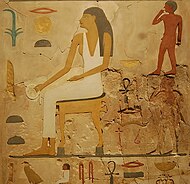| Itet | |
|---|---|
 Itet and two of her sons (an unknown son and Ankherfenedjef) in a scene from her tomb at Meidum (Oriental Institute, Chicago) Itet and two of her sons (an unknown son and Ankherfenedjef) in a scene from her tomb at Meidum (Oriental Institute, Chicago) | |
| Spouse | Nefermaat |
| Children | Djefatsen, Isesu, Hemiunu, Isu, Teta, Khentimeresh, Pageti, Itisen, Inkaef, Serfka, Wehemka, Shepseska, Kakhent, Ankhersheretef, Ankherfenedjef, Buneb, Shepsesneb, Nebkhenet |

Itet (fl. c. 2570 BCE) also known as Atet, was a royal woman who lived in ancient Egypt. She was the wife of Nefermaat, who was the eldest son of king Sneferu as well as a vizier and a religious leader in the royal court who officiated in the worship of Bastet. She was the mother of three daughters and many sons. Her son, Hemiunu, succeeded her husband as vizier. She and her husband are buried in mastaba 16 at Meidum. Their tomb is famous for paintings of geese, and of other animals, as well as depictions of daily family life.
Family
Fifteen of Itet and Nefermaat's offspring are named in their tomb in Meidum. Daughters Djefatsen and Isesu and sons Hemiunu, Isu, Teta, and Khentimeresh are depicted as adults, while daughter Pageti and sons Itisen, Inkaef, Serfka, Wehemka, Shepseska, Kakhent, Ankhersheretef, Ankherfenedjef, Buneb, Shepsesneb, and Nebkhenet are depicted as children. Her son, Hemiunu, is the vizier who is believed to have helped plan the Great Pyramids for Khufu and he often is referred to as its architect.
References
- Callahan, David (2014-08-14). A History of Birdwatching in 100 Objects. A&C Black. ISBN 978-1-4081-8665-7.
- Nefermaat and Itet Archived 2010-05-13 at the Wayback Machine
- Petrie, William Matthew Flinders, ed. (2013), "MEYDUM", Ehnasya, The Labyrinth, Gerzeh and Mazghuneh, Cambridge Library Collection - Egyptology, Cambridge: Cambridge University Press, ISBN 978-1-108-06620-4, retrieved 2024-04-10
- Davies, Vanessa; Laboury, Dimitri (2020-02-28). The Oxford Handbook of Egyptian Epigraphy and Palaeography. Oxford University Press. ISBN 978-0-19-008373-1.
- Urbani, Bernardo; Youlatos, Dionisios; Antczak, Andrzej T. (2022-08-18). World Archaeoprimatology: Interconnections of Humans and Nonhuman Primates in the Past. Cambridge University Press. ISBN 978-1-108-48733-7.
- Santillian, Beatriz; Thomas, Susanna (2017-07-15). Snefru: Pharaoh of the 4th Dynasty. The Rosen Publishing Group, Inc. ISBN 978-1-5081-7491-2.
- Reader, Colin (2015). "The Meidum Pyramid". Journal of the American Research Center in Egypt. 51: 203–224. doi:10.5913/jarce.51.2015.a010 (inactive 1 November 2024). ISSN 2330-1880.
{{cite journal}}: CS1 maint: DOI inactive as of November 2024 (link) - Dodson, Aidan and Hilton, Dyan. The Complete Royal Families of Ancient Egypt. Thames & Hudson. 2004. ISBN 0-500-05128-3, pp.52-53, 56-61